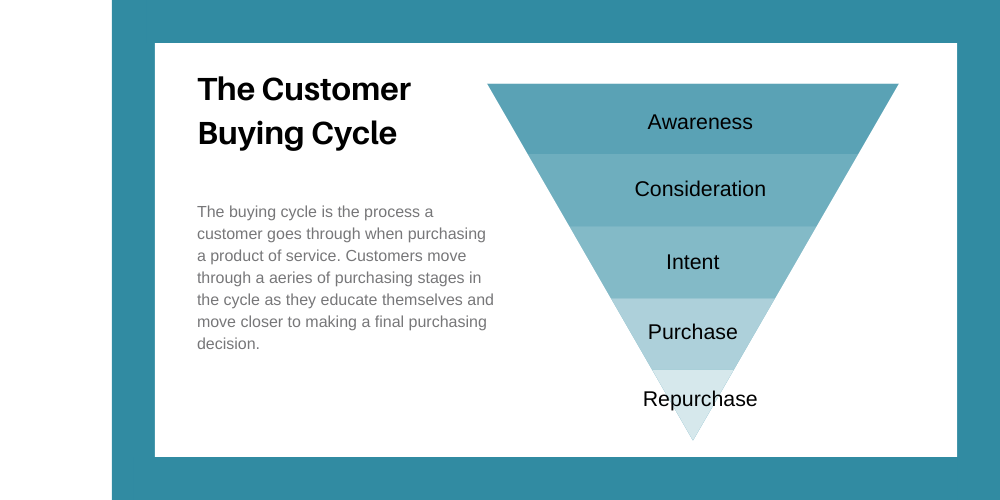If you work in B2B sales or business development you need to read this article. How many sales people enjoy cold calling? How many customers like receiving a cold call? Very few, but why is this? Simple – they are not ready to buy or do not need what was being offered. This is where the buying cycle comes in. The secret to successful sales is to know when and how to approach your customer – to be there just at the right moment when they are in ‘buying mode’ and have a need for your product or service. But how can you possibly know when this is? Read on to learn more.
The Buying Cycle
The Buying Cycle or Sales Cycle is very simple. It can be defined as: ‘The process a customer goes through when purchasing a product or service’. Customers move through a series of purchasing stages in the cycle as they educate themselves and move closer to making a final purchasing decision. By understanding the buying cycle sales people can adapt their approach to sales, cease cold calling and dramatically increase their likelihood of success. Let’s show you how.
Firstly you need to understand the 5 stages of the buying cycle:

Stage 1: Awareness
Potential customers realise they have a problem or a need and begin thinking about how they might solve it. This is the stage where good marketing can really help and hense where businesses focus a lot of marketing effort. As a sales person there is much that you can do at this stage – anything that raises awareness with your target customers eg attending events and exhibitions or being active on LinkedIn. If you have a marketing department – aim to try and work with them for a ‘joined-up approach’.
Stage 2: Consideration
The customer starts to look for solutions. This is where the work of the salesperson can start to make a difference. Your job at this stage is to provide detailed information explaining how your product or service can solve their problem better than the competition and what the benefits of it are. If marketing activity has been successful you should begin to receive enquiries or leads about your products or services. By responding to these enquiries efficiently and appropriately you will be paving the way for future sales. This is a good time for some fact-finding – try and set up an initial call with your customer to learn more about them and their needs. Ask lots of open questions.
Stage 3: Intent
This is where the buyer will begin to compare the different options. Whichever makes the most logical, emotional or financial sense will be the one they select. As a sales person your job is now to convince customers that your product or service is the one they should choose. You may be given the opportunity to pitch or put a proposal to your potential customer. Make sure your proposal is well researched and relevant to your customer’s needs. Use the knowledge you gained stage 2 to tailor your proposal appropriately.
Stage 4: Purchase
The customer has decided what they want to buy and they proceed to make a purchase. As a sales person your role is to not only to secure the deal at the right price but to ensure you put the ground work in to begin developing a long term relationship with your customer. You need to provide support, handle any queries and ensure the buying process runs smoothly and your products/services are delivered to a high quality, in a timely manner in line with your original offering.
Stage 5: Repurchase
It’s much easier to win repeat business and find new business. So make sure your customers become repeat customers by providing a top quality follow up and aftersales service. It’s at this stage that you have the biggest opportunity for increasing revenue.
How to Adapt your Sales Process
So why is the buying cycle important in understanding why cold calling does not work? It all comes down to human psychology. Fundamentally we tend not to like feeling we are being sold to or pushed into making a decision. Conversely we do like it when someone helps provide a solution to a problem that we have. So revisit the Buying Cycle above and think about when in this cycle a cold call in a B2B context might be appropriate. The answer is nowhere. So what should you do? You need to adapt your sales process to work with the Buying Cycle – not against it. Just take each stage of the buying cycle and match your sales activities appropriates.
A: Identify your Target Customers
B: Categorise your customers into where you believe they are current at in the buying cycle
C: Adapt your sales activities to match the stage of the cycle that you believe each customer is at. If you’re not sure what stage they are at a few open questions should quickly reveal this.
Good luck and enjoy your new found sales success – without ever making another cold call.

